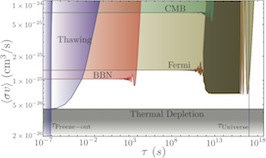Without solid experimental input, the underlying particle physics behind dark matter remains an open question. For many years, the leading paradigm was of a weakly interacting particle that was a thermal relic of the Big Bang. This leads to interesting theoretical possibilities connecting dark matter with possible extensions of the Standard Model of particle physics that solve the naturalness and hierarchy problem, such as supersymmetry.
However, we know of another set of particles in the Universe whose abundance is not due to being a thermal relic: the protons and neutrons that make up all the atoms we see. Their abundance is due to a fundamental asymmetry in nature: a charge-parity (CP) violation. It is possible that a similar scenario exists for dark matter.
In a recent work (http://arXiv.org/abs/arXiv:1109.2164), Matthew Buckley (FNAL) and Stefano Profumo (UCSD) demonstrated that in such asymmetric dark matter models, the possible oscillation at late times between dark matter and its anti-matter counterpart could be observed in a variety of experiments. The lack of such signals places significant constraints on asymmetric models (below, for a 10 GeV dark matter particle), and provides motivations for future theoretical work.
– Matthew Buckley










